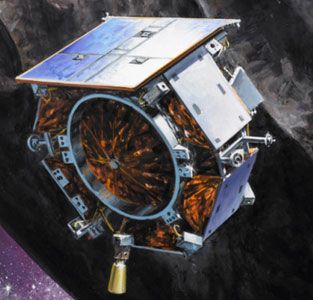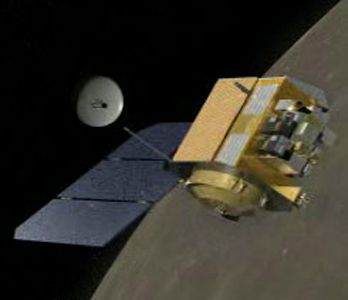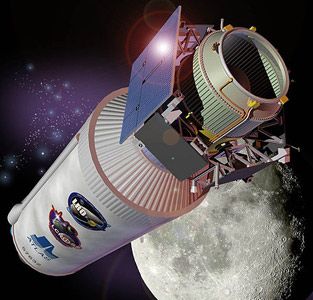
Home - Search - Browse - Alphabetic Index: 0- 1- 2- 3- 4- 5- 6- 7- 8- 9
A- B- C- D- E- F- G- H- I- J- K- L- M- N- O- P- Q- R- S- T- U- V- W- X- Y- Z
LRO
 LCROSS Credit: Manufacturer Image |
AKA: LCROSS. Status: Operational 2009. First Launch: 2009-06-18. Last Launch: 2009-06-18. Number: 2 . Gross mass: 1,000 kg (2,200 lb).
The spacecraft's mission was to prepare the way for future Project Constellation manned landings by determining the location and extent of possible water ice below the lunar surface; and to comprehensively map the surface to allow planning for future manned landings and bases. LRO would also observe the LROSS impact probe's debris cloud to determine the amount of subsurface ice in the permanently shadowed area of a single polar crater. Project Constellation was however cancelled before the spacecraft completed its mission. The satellite's payloads were:
- CRaTER: Cosmic Ray Telescope for the Effects of Radiation to characterize the global lunar radiation environment
- DLRE: Diviner Lunar Radiometer Experiment to measure lunar surface thermal emission
- LAMP: Lyman-Alpha Mapping Project ultraviolet telescope, to detect water ice in permanently shadowed craters
- LEND: Lunar Exploration Neutron Detector to detect possible near-surface water ice deposits
- LOLA: Lunar Orbiter Laser Altimeter to provide a precise global lunar topographic model and geodetic grid
- LROC: Lunar Reconnaissance Orbiter Camera to provide images for future manned landing site certification. LROC included a pair of narrow-angle cameras (NAC) and a single wide-angle camera (WAC)
- Mini-RF: Miniature Radio Frequency radar to demonstrate lightweight SAR and communications technologies and locate potential water-ice
NASA NSSDC Master Catalog Description
The Lunar Reconnaissance Orbiter (LRO), the first mission of NASA's Robotic Lunar Exploration Program, is designed to map the surface of the Moon and characterize future landing sites in terms of terrain roughness, usable resources, and radiation environment with the ultimate goal of facilitating the return of humans to the Moon. The following measurements have the highest priority: characterization of deep space radiation environment in lunar orbit; geodetic global topography; high spatial resolution hydrogen mapping; temperature mapping in polar shadowed regions; imaging of surface in permanently shadowed regions; identification of putative deposits of appreciable near-surface water ice in polar cold traps; assessment of meter and smaller scale features for landing sites; and characterization of polar region lighting environment. A primary goal of the mission is to find landing sites suitable for in situ resource utilization (ISRU).
LRO launched along with its companion spacecraft, the Lunar Crater Observation and Sensing Satellite (LCROSS), from Kennedy Space Center on 18 June 2009 on an Atlas 5 401 launch vehicle at 21:32 UT (5:32 p.m. EDT). LRO and LCROSS separated at 22:16:43 UT. LRO was put into a direct insertion trajectory and reached the Moon on 23 June at 09:43 UT (5:43 a.m. EDT). It entered an initial 5 hour orbit with a periselene altitude of roughly 100 km which was lowered into a 50 km circular orbit. The mission spent one year in a 30 - 70 km altitude lunar polar orbit, called the exploration phase of the mission. In September 2010 it started the science phase, where it was put into a quasi-stable, low-maintenance ~30 x 180 km orbit. As of September 2015 it was in its second extended science mission. The satellite had a launch mass of about 1846 kg, and a dry mass of less than 949 kg. The platform is three-axis stabilized and power of about 1850 W (end-of-life), giving 800 W average over each orbit, will be provided by a 10.7 square meter solar array and stored in an 80 A-hr Li-ion battery. Communications are via S-band for uplink and low rate downlink and Ka-band for high rate downlink (100-300 Mbps). The spacecraft carries 92 kg of scientific payload composed of: Lunar Reconnaissance Orbiter Camera (LROC), two narrow-angle (1 m resolution) monochromatic cameras and one wide-angle (100 m resolution) color and UV camera to acquire images of small scale landing site hazards and document lighting conditions at the lunar poles; Lunar Orbiter Laser Altimeter (LOLA), a laser altimeter to measure landing site slopes and search for polar ices; Lunar Exploration Neutron Detector (LEND), a neutron detector to search for water ice and characterize the space radiation environment; Diviner Lunar Radiometer Experiment (DLRE), a radiometer to map the temperature of the lunar surface to identify cold traps and possible lunar ice deposits; Lyman-Alpha Mapping Project (LAMP), a Lyman-alpha mapper to observe the lunar surface in the far ultraviolet, looking for surface ices and frosts and imaging permanently shadowed regions; and Cosmic Ray Telescope for the Effects of Radiation (CRaTER), a device to investigate background space radiation using tissue-equivalent plastics. NASA has also signed an agreement with the U.S. National Reconnaissance Office to cooperate on the development of Mini-RF, a miniature synthetic aperture radar sensor to map the Moon's surface. Total payload power requirement is about 125 W. The total estimated total cost for the mission is roughly $460 million.
LCROSS
The Lunar Crater Observation and Sensing Satellite (LCROSS) was launched along with the LRO spacecraft. LCROSS is designed to search for water ice on the Moon's surface. The mission consists of a Shepherding Spacecraft (S-S/C) attached to the Centaur upper stage. The S-S/C guided the Centaur after orbital insertion through two highly eccentric 40 day earth orbits. The S-S/C then guided the Centaur into a trajectory to impact Cabeus, a permanently shadowed site on the Moon, chosen for its likelihood of containing water ice. The S-S/C separated from the Centaur and performed a delay burn to follow ten minutes behind. The Centaur impacted the lunar surface at 11:31 UT on 9 October 2009, throwing up a cloud of debris. The S-S/C took images and collected other data on the impact and cloud of ejecta before also striking the Moon at 11:36 UT. The S-S/C was built on an EELV Secondary Payload Adaptor (ESPA) ring with a dry mass of approximately 534 kg and 300 kg of hydrazine propellant. Power is supplied by a 420 W solar array charging a 40 A-h Li-Ion battery. Propulsion is through two 8-thruster pods and communications will be via two omnidirectional and two horn antennas. The S-S/C was equipped with two visible cameras, three infrared cameras, three spectrometers, and a photometer for observations.
More at: LRO.
Family: Moon. Country: USA. Launch Vehicles: Atlas V, Atlas V 401. Launch Sites: Cape Canaveral LC41. Bibliography: 11371, 12767.
 | LRO Credit: Manufacturer Image |
 | LCROSS Credit: Manufacturer Image |
2009 June 18 - . 21:32 GMT - . Launch Site: Cape Canaveral. Launch Complex: Cape Canaveral LC41. Launch Pad: SLC41. LV Family: Atlas V. Launch Vehicle: Atlas V 401.
- LRO - . Nation: USA. Agency: Martin. Class: Moon. Type: Lunar orbiter. Spacecraft: LRO. USAF Sat Cat: 35315 . COSPAR: 2009-031A. Lunar Reconnaissance Orbiter.
- LCROSS - .
Nation: USA.
Agency: Martin.
Class: Moon.
Type: Lunar impacter. Spacecraft: LRO.
Decay Date: 2009-10-09 . USAF Sat Cat: 35316 . COSPAR: 2009-031B.
Lunar impact probe, designed to detect ice in the lunar polar regions. LCROSS and the Centaur stage flew 3270 km from the Moon at 1030 GMT on June 23 and were hurled to a 5820,00 km apogee. On 9 October LCROSS separated from the Centaur. The Centaur impacted in Cabeus crater at 11:31 GMT on 9 October followed by LCROSS at 11:35 GMT. The impacts did not produce the expected spectacular impact plume as expected. However later data reduction did show significant amounts of water.
Back to top of page
Home - Search - Browse - Alphabetic Index: 0- 1- 2- 3- 4- 5- 6- 7- 8- 9
A- B- C- D- E- F- G- H- I- J- K- L- M- N- O- P- Q- R- S- T- U- V- W- X- Y- Z
© 1997-2019 Mark Wade - Contact
© / Conditions for Use